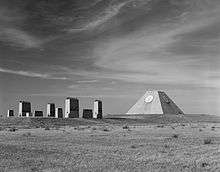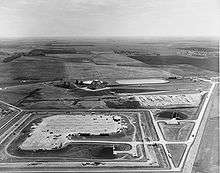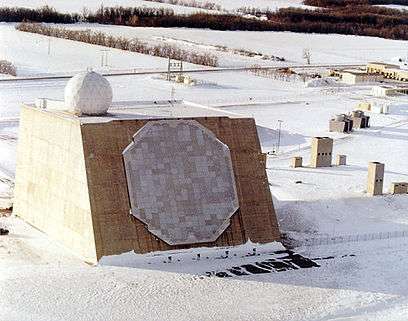Stanley R. Mickelsen Safeguard Complex
The Stanley R. Mickelsen Safeguard Complex (SRMSC) was a cluster of military facilities near Grand Forks, North Dakota, that supported the United States Army's Safeguard anti-ballistic missile program.[1] The complex provided launch and control for 30 LIM-49 Spartan anti-ballistic missiles, and 70 shorter-range Sprint anti-ballistic missiles.

The deployment area of the complex covered the Minuteman launchers of the 321st Strategic Missile Wing, based at Grand Forks Air Force Base, North Dakota. Under the terms of the 1972 Anti-Ballistic Missile Treaty, the US was permitted to deploy a single ABM system protecting an area containing ICBM launchers. The total of 100 launchers and 100 missiles was the maximum permitted under the treaty.
The site achieved initial operating capability on 1 April 1975, and full operational capability on 1 October 1975 costing over $2 Billion adjusted for inflation. The House of Representatives voted to decommission the project on 2 October 1975 after they deemed it ineffective. The complex was deactivated on 10 February 1976, after less than a year of operation and 24 hours of full operational capacity. In December 2012, it was purchased by the Spring Creek Hutterite Colony of Forbes, North Dakota, at auction for $530,000.[2][3] In 2020, portions of the property including the Pyramid were sold to the Cavalier County Job Development Authority (CCJDA) for $462,900.[4] The CCJDA intends to build an interpretive historical center, restore the property, and sell or lease the pyramid to a datacenter or similar business. The Hutterite colony retains ownership of the remaining property.
The site was named for Stanley R. Mickelsen, a former commanding general of the U.S. Army Air Defense Command.
Facilities
The complex was centered on the Missile Site Radar (MSR) site, near to Nekoma, North Dakota, home to the Missile Site Radar itself, as well as the 30 Spartan missiles and 16 of the shorter-range Sprints. All missiles were held in underground launch silos.
The remaining Sprint missiles were distributed at four Remote Sprint Launchers at distances of 10 to 20 miles (16 to 32 km) from the Missile Site Radar. These were located at:
- RSL 1 48°32′00.24″N 98°34′58.81″W
- RSL 2 48°50′58.03″N 98°25′55.84″W
- RSL 3 48°45′52.63″N 97°59′9.92″W
- RSL 4 48°28′30.91″N 98°15′23.02″W
The Perimeter Acquisition Radar (PAR) was a separately sited phased array radar intended to detect incoming targets. The radar and site remain in service today as the Perimeter Acquisition Radar Characterization System (PARCS), located at Cavalier Air Force Station.
The MSR and PSR sites are listed in the Historic American Engineering Record, a Heritage Documentation Program.[5]
Images gallery
 Aerial image of the MSR site
Aerial image of the MSR site Aerial image of Remote Sprint Launch Site No. 2.
Aerial image of Remote Sprint Launch Site No. 2. The PAR, now known as EPARCS, is still in operation
The PAR, now known as EPARCS, is still in operation
References
-
James Walker, Lewis Bernstein (2003). Seize the High Ground: The Army in Space and Missile Defense. Defense Department, Army, History Office, Space and Missile Defense Command. ISBN 0-16-072308-6.
On 21 June 1974, Army officially designated the SAFEGUARD tactical facilities in North Dakota the Stanley R. Mickelsen SAFEGUARD Complex
- "Stanley R. Mickelsen Safeguard Complex: A Strange Pyramid Built in the Middle of Nowhere", from Weather.com
- "Anti-Ballistic Missiles and the Hutterites", by Bryan Burba, Peaceful Societies
- https://www.coldwartourist.com/stanley-r-mickelsen-safeguard-complex
- Historic American Engineering Record HAER ND-9-B HAER ND-9-P
External links
- srmsc.org - unofficial site, dedicated to the Stanley R Mickelsen Safeguard complex
- Library of Congress archives
- - Google Earth Image of Complex.